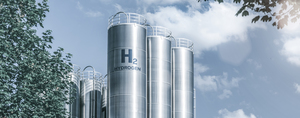
 |
Charlotte Stonestreet
Managing Editor |
| Home> | MACHINE BUILDING & ENGINEERING | >Materials & Components | >Adhesives to help hydrogen economy |
Adhesives to help hydrogen economy
29 August 2024
HYDROGEN: THE most abundant chemical substance in the universe… and, potentially, the key to unlocking a healthier future for planet Earth.

Experts across a range of sectors – energy, sustainability, politics – believe that harnessing hydrogen as a power source will help solve many of the issues we currently face.
For starters, the burning of hydrogen to generate energy produces nearly no pollution. Certainly, a fraction of that is caused by carbon-based fossil fuels. As such, the emerging ‘hydrogen economy,’ as it is known, is at the heart of global decarbonisation strategies.
Additionally, the abundance of hydrogen means it is perfect for energy independence, compared to the current energy economy where supply and demand is dictated by a handful of oil and gas sources.
Switching to hydrogen is an exciting prospect. Inevitably, there will be teething troubles along the way, with several critical factors that will determine the success of the hydrogen economy.
Safety and environment
Why hasn’t hydrogen been used until now? Like any gas, it needs to be controlled safely. Hydrogen is highly flammable and, in confined environments, can displace oxygen and lead to asphyxiation.
To compound this, hydrogen is odourless, colourless and tasteless, so it is hard to detect any leaks that might lead to more serious issues.
According to the US-based Environmental Defence Fund, it’s possible that as much as 20% of hydrogen leaks throughout the value chain.
As clean hydrogen projects surge in popularity, the question of leakage takes on a particular urgency. Detect – or prevent? This is an issue that affects the entire value chain, from production, through to delivery, and end use.
Efficiency
Clearly, the long-term success of any emerging technology depends on its efficiency. Can it produce the required quantity and quality of energy, at scale, without wastage or unnecessary process? With this in mind, optimising the operational cost will be critical.
In hydrogen production through electrolysis, the primary areas where efficiency can be improved are at the cell, stack and system level. The durability and service life of equipment,
Compatibility
Last but not least, the hydrogen economy is still evolving. How can manufacturers be sure they are using the right product or process? Effective testing and certification are crucial to delivering a safe, effective value chain.
The role of adhesives
Adhesives already play a vital role in bonding and sealing many of the machines likely to be deployed by the hydrogen economy. From valves, pumps and compressors, to trains and pipelines, through to engines and boilers – it’s likely that adhesives will be used.
The same is true for the more specialised equipment integral to hydrogen production, such as electrolysers and electrolysis systems. Considering just this part of the value chain, adhesives are used to seal components through thread sealing, flange sealing or threadlocking, and to bond metal components.
Such core products are then supported by gas leakage monitoring and H2 barrier coating products, for a dedicated hydrogen adhesive portfolio.
Handling the pressure
Given the importance of preventing leaks, the onus is on the adhesives sector to ensure that equipment is sealed effectively to cope under different pressures. Thread and flange seals work by creating 100% fill, permanent seals to deal with this – but proof is critical.
There are currently no universal standards for the sector, except ISO 22734 for hydrogen generators. Yet the same challenges are faced by other devices such as electrolysers or fuel cells.
That’s why LOCTITE has developed its own internal test, based upon – but going beyond – the test standards established by Kiwa, a Netherlands-based certification body for hydrogen sealing.
The future, today
LOCTITE has already worked extensively with customers involved in the hydrogen economy, and this field experience helps us to deliver the best advice for different scenarios. We know, from specific customer applications, that LOCTITE 638 eliminates leaks from the threads of hydrogen compressors, withstanding up to 100 bar pressure. Likewise, a combination of LOCTITE 246 and LOCTITE 565 is ideal for replacing PTFE tape for sealing threads of hydrogen purifiers.
These are just two examples of what can be achieved, but long-term success is an ongoing process. Our experts are available to collaborate on new projects, to drive sustainable change and help to build a healthy future for the hydrogen economy.



















